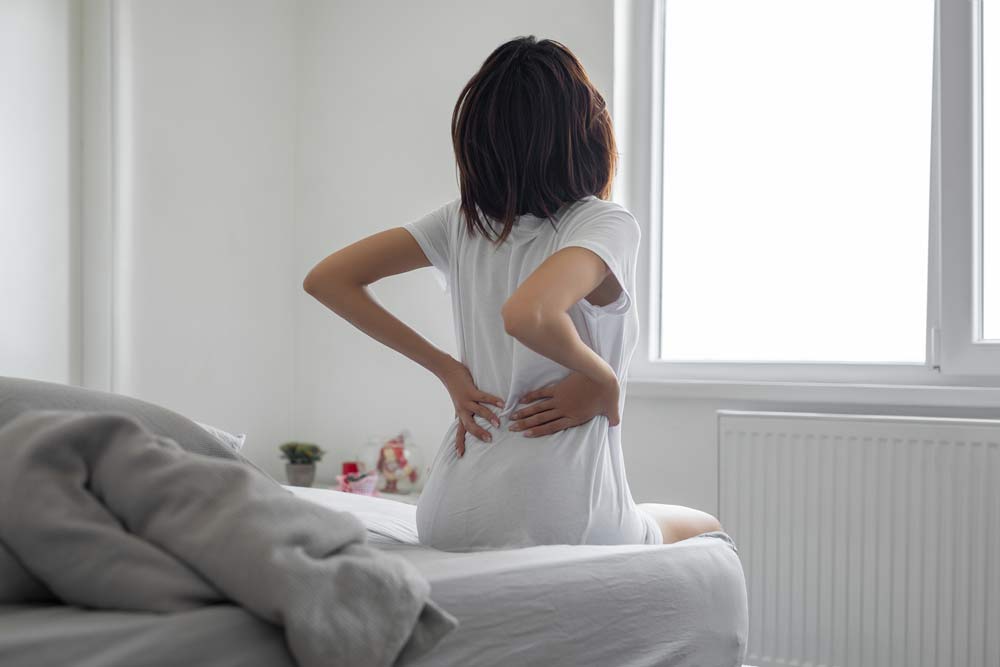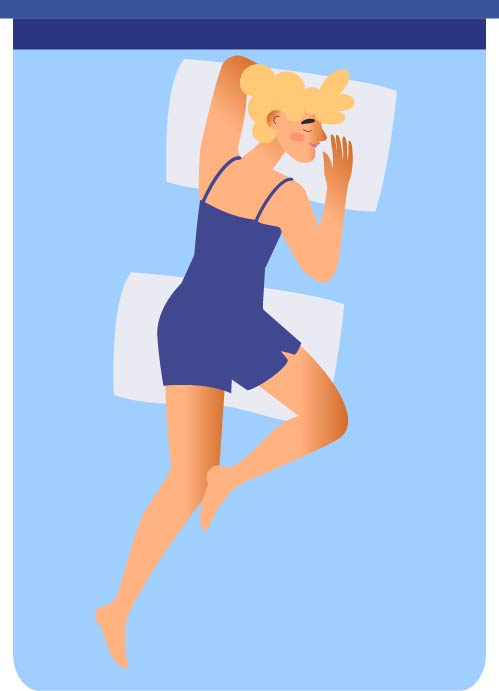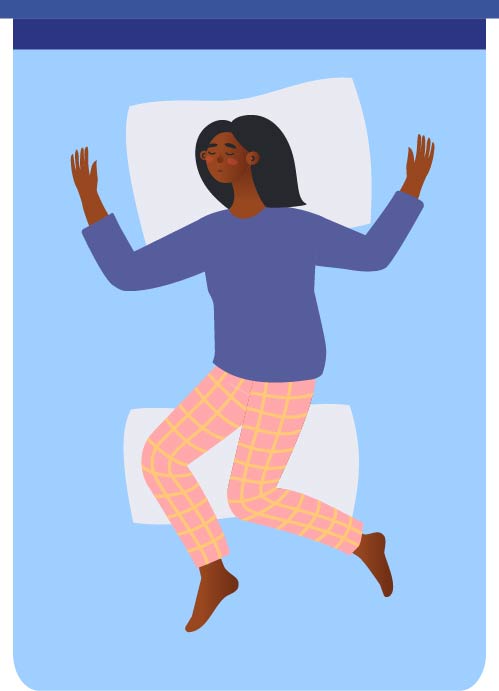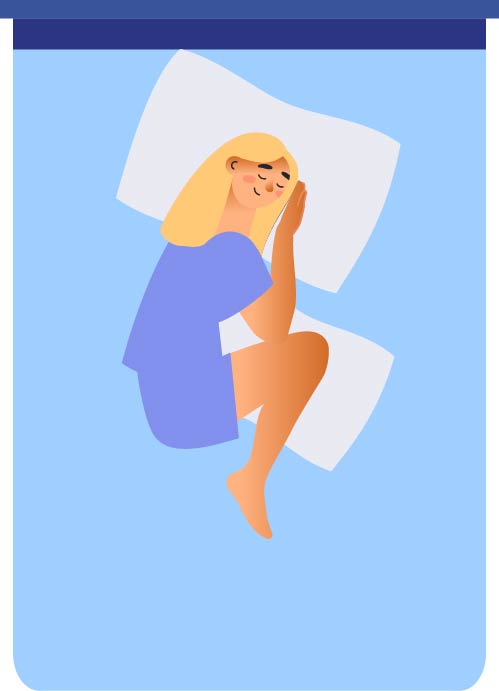At Sleepopolis, we’re constantly monitoring new sleep health developments in order to keep our articles as up-to-date and accurate as possible.
How To Sleep With Lower Back Pain
- by Lauren Panoff
- Updated: October 4, 2024

Written by Lauren Panoff, RD, Health Writer
Methodology
Just Updated
This article has been updated to reflect more up-to-date advice around sleeping with lower back pain.

Picture it: You’ve just woken up after a horrendous night of sleep, your night of rest disrupted by the relentless nagging of lower back pain. Many of us can relay a similar story, whether your back pain is triggered by a longstanding problem or an acute injury that’s baring its teeth whenever you try to lie down. As such, wondering how to sleep with lower back pain is a common struggle.
While the consequences are largely the same, there are numerous things that can cause lower back pain, which can range from a daytime injury to regularly sleeping on an unsupportive mattress. Figuring out what may be behind yours is a good start so you can make any necessary changes.
In the meantime, it’s important that you get back to quality sleep, which is why we’re covering the connection between lower back pain and sleep, including the best (and worst) sleeping positions when you’re dealing with it.
Note: The content on Sleepopolis is meant to be informative in nature, but it shouldn’t be taken as medical advice, and it shouldn’t take the place of medical advice and supervision from a trained professional. If you feel you may be suffering from any sleep disorder or medical condition, please see your healthcare provider immediately.
Long Story Short
- Lower back pain can be acute or chronic and might be caused by factors like physical injuries, poor posture, muscle strain.
- Lower back pain can make it harder to fall asleep and stay asleep, and not getting restorative sleep can make your pain back worse.
- Finding the appropriate intervention for lower back pain is important, which might include trying a new spine-neutral sleeping position, investing in a more supportive mattress, and/or speaking to your doctor for medical guidance.
Causes of Lower Back Pain
There could be many reasons that your lower back isn’t feeling quite right, which are often related to lifestyle habits that are working against you or specific physical health issues.
Dylan Petkus, M.D., founder at Optimal Circadian Health, says, “ Imagine your spine like a tower of Legos; if those blocks aren’t perfectly lined up, the whole structure is wobbly and painful.”
First, many of us are guilty of practicing poor posture during the day. With so many of our day jobs involving prolonged sitting or standing, this can strain the muscles and ligaments in the lower back and cause discomfort. It’s not uncommon to be working at a desk all day only to suddenly realize you’ve been hunched over for the better part of an hour (AKA poor ergonomics). (1)
Muscle strain is another common culprit, often resulting from overexertion, heavy lifting, or sudden movements that “tweak” your back muscles (like that time you decided to join the impromptu break-dancing competition at your cousin’s wedding). Add citation
Carrying extra body weight also places extra pressure on your spine, which increases the risk of injury and pain in your lower back. (2)
Physical problems can also cause lower back pain, such as herniated discs, in which your spinal discs bulge or rupture and press on nearby nerves. This can also cause concerning numbness or tingling. (3)
Finally, your everyday habits are key. For instance, leading a sedentary lifestyle, characterized by a lack of regular intentional exercise, can also contribute to lower back pain. Factors like stress and even smoking can further exacerbate pain by weakening your muscles and ultimately reducing blood circulation to your spinal tissues. (4)(5)
Types of Lower Back Pain
Understanding the type of lower back pain you’re experiencing can help you navigate the best treatment and recovery strategies. To start, lower back pain can be categorized into two main types: acute and chronic. (6)
- Acute Lower Back Pain: This type of pain typically lasts for a short duration, often less than six weeks. It could be a result of sudden injuries like muscle strains, sprains, or trauma from a car accident. Acute pain tends to improve with rest, over-the-counter medications, and physical therapy. (6)
- Chronic Lower Back Pain: Pain that persists for more than 12 weeks is classified as chronic. It can develop gradually or come after you have an acute injury that never fully heals. Chronic pain may be caused by underlying conditions such as arthritis, degenerative disc disease, or nerve damage, and often requires long-term management through therapies, medications, and sometimes surgery. (6)
In some cases, acute back pain can turn into a chronic problem. One meta-analysis of 12 studies involving 5459 people found that approximately 84 percent of people reported suffering from low back pain during their lifetime, and 23 percent eventually developed chronic low back pain. (1)
The Connection Between Lower Back Pain and Sleep
If you’ve ever tried to sleep when your lower back is throbbing, you’re already familiar with the connection between the two. Not only can lower back pain negatively affect your ability to sleep, but a lack of decent sleep can also worsen your back pain. (7)
Petkus says,”If you sleep in a way that causes your spine to twist or puts uneven pressure on your lower back, you can develop muscle, ligament and disc strain in that area.”
When your back hurts, it can feel nearly impossible to find a comfortable position to relax in — let alone sleep — which can lead to overall poor sleep quality, frequently waking up during the night, and trouble falling asleep at all.
Kevin Lees, director of chiropractic operations at The Joint Chiropractic, broke down the connection between lower back pain and sleep for us depending on the type of sleeper you are:
- Back sleepers: When sleeping on one’s back, the weight of the legs can push the hips and pelvis down, increasing the lower back curve. For some, this can cause back pain due to the increased stress on the spinal joints.
- Side sleepers: Side sleepers often experience lower back and pelvis twisting. Ideally, the spine should remain neutral to alleviate added stress.
- Stomach sleepers: Like back sleeping, sleeping on one’s stomach can increase the lower back curve. This added stress can aggravate the joints in the lumbar spine. Stomach sleeping can also affect neck, shoulder and upper back, so it’s not a recommended position.
In turn, when your body suffers from a lack of restorative sleep, this can exacerbate back pain by increasing sensitivity to discomfort and slowing down its natural healing processes. Plus, factors like poor sleeping posture, an improper pillow or mattress, or inconsistent sleep hygiene habits can make this worse. (8)
The Best Sleeping Positions for Lower Back Pain
Choosing the right sleeping position is essential for managing lower back pain. Doing so not only helps you fall asleep and stay asleep during the night, but can also prevent worse pain in the morning.
Lees says specific positions aggravate certain injuries and that maintaining a neutral position (a sleeping position that keeps the natural curves of your spine intact) is typically the most common recommendation. “Sleeping on your back or side can be comfortable with proper support (like pillows or body pillows as necessary)”, he adds.
Petkus says that the best position for someone with low back pain is to lie on their back with a pillow under the knees. “This position is helpful because it maintains the lumbar curve, keeps weight equally distributed over the body, and minimizes the load on the lower back.”
“Another good sleeping position is side sleeping with a pillow between the knees,” Petkus notes, because it also helps to maintain a neutral spine position. (9)
Of course, the best sleeping position for one person may not be the same one for someone else. Consider trying these sleep positions out to see which one(s) work best for your needs:



- Side sleeping with a pillow between the legs helps keep the spine in alignment, reducing strain on the lower back. (9)
- For back sleepers, placing a pillow under the knees supports the natural curve of the spine, relieving pressure on the lower back. (10)
- Stomach sleepers can reduce strain by placing a pillow under the hips to support the lower spine. (10)
- The fetal position, where you curl on your side with your knees drawn up, can also relieve tension by opening up space between the vertebrae. (11)
Additionally, using a firm pillow topper can provide extra support and help maintain proper spinal alignment, reducing discomfort during sleep.
The Worst Sleeping Positions for Lower Back Pain
Just as some sleeping positions can be therapeutic for lower back pain, others can make it worse by putting extra stress on the spine. One of the most important considerations when choosing a sleeping position for lower back pain is finding one that allows your spine to be neutral.
According to Petkus, sleeping on your stomach is the worst position for lower back pain. He notes that this position forces the neck to twist and the lower back to arch, which can put excessive strain on the spine. “It’s like trying to balance a heavy load on an unstable surface — the misalignment creates tension and pain,” he says.
Lees agrees, stating that your mattress should fully support your body, and to sleep on your stomach, you often have to prop yourself up on an angle to breathe or twist your neck to one side while extending it slightly. “With your lower back flat, your natural curve can be increased, which may cause pain,” he says.
Sleeping in a twisted or uneven posture, like with one leg higher than the other or lying on your side without a pillow between your knees, can also misalign your spine, exacerbating pain.
Finally, cushy mattresses and pillows may seem like a cozy idea, but they’re not great for your back. Overly soft bedding won’t offer proper support and can also worsen the pain, as it allows your body to sink into awkward positions that strain the back muscles.
Can A Mattress Cause Lower Back Pain?
Yes, a mattress can play a role in lower back pain if it doesn’t provide proper support or promote good spinal alignment. And as it turns out, finding the right mattress for lower back pain prevention is very much a Goldilocks story.
“A mattress should provide full body support, keeping the spine neutral,” says Lees. When it loses support, it can cause sagging in the most worn areas and cause you to feel like you’re sleeping in a “C” shape. “This over time can lead to waking up sore, not getting a good night’s rest, tossing and turning, and even long-term injuries.”
That’s why if you have existing lower back pain, a good rule of thumb is to choose a medium-firm to firm mattress, as is recommended by sleep experts. This type of mattress supports the natural curvature of your spine without allowing you to sink too much or put extra pressure on your back. (12)(13)
On the other hand, Petkus tells us, “A mattress that’s too hard can cause pressure points (hips and shoulders are the usual culprits), also resulting in pain.” Instead, you want a mattress that’s supportive enough to keep your spine neutral, but with enough cushioning that you feel comfortable. “Finding that balance between support and comfort leads to pain-free slumber,” he says.
While you’re considering the pros and cons of your mattress, you might be interested in an adjustable bed base. This option allows you to customize your sleeping position even more. For instance, you could slightly elevate your head and feet to reduce lower back strain and promote better spinal alignment.
When to See a Doctor About Lower Back Pain
Fortunately, many cases of lower back pain are temporary and resolve on their own with a little extra rest and self-care. However, there are other times when it’s important to seek personalized medical guidance.
“If you have low back pain that persists for more than three or four weeks, or if you have back pain that wakes you at night and/or is associated with numbness, tingling and/or weakness in your legs, see your physician,” Petkus tells Sleepopolis. He notes that these kinds of symptoms could indicate an underlying issue, such as a herniated disc or spinal stenosis, where professional treatment is warranted. “Those are cases where your body is waving a red flag – don’t ignore that,” he adds. (14)
Immediate medical attention should be sought if you experience severe, sudden pain after a trauma to your body, are having trouble controlling your ability to use the bathroom, or notice unexplained and unintentional weight loss.
Lees says that back pain that starts for an unknown reason can worsen over time, affecting quality of sleep and creating new health problems. It’s important to be aware of these potential issues and speak with your doctor. “Sleep quality can affect weight gain, stress hormones, healing rate, and even focus ability,” he says. (15)(16)(17)(18)
Finally, any time you’re concerned about your health is a good reason to speak with your healthcare provider — that’s what they’re there for. A doctor can help you identify underlying causes of your lower back pain and help determine appropriate treatment interventions.
FAQs
How to sleep with lower back pain and sciatica
To sleep with lower back pain and sciatica, try lying on your side with a pillow between your knees to keep your spine aligned and minimize pressure on your nerves. Alternatively, sleeping on your back with a pillow under your knees can relieve tension in the lower back and minimize sciatic nerve pain.
How to sleep with lower back pain during pregnancy
To sleep with lower back pain during pregnancy, lie on your side with a pillow between your legs and under your belly to support the spine and alleviate pressure. Using a pregnancy pillow or extra cushions for added comfort can also help maintain proper alignment and reduce lower back discomfort.
The Last Word From Sleepopolis
It’s hard to sleep well when you have lower back pain, and this pain can be worsened when you’re not sleeping. To disrupt this vicious cycle, it’s important to try and identify the root cause(s) of your pain and make necessary adjustments to your lifestyle, sleeping position, or perhaps your bed (and mattress) itself. Consider trying the tips we mentioned above and consult with your doctor if your lower back pain gets worse so you can get back to pain-free, restful sleep ASAP. Here’s to making sleeping with lower back pain a thing of your past.
Sources
- Du SH, Zhang YH, Yang QH, Wang YC, Fang Y, Wang XQ. Spinal posture assessment and low back pain. EFORT Open Rev. 2023;8(9):708-718. Published 2023 Sep 1. doi:10.1530/EOR-23-0025
- Siddiqui AS, Javed S, Abbasi S, Baig T, Afshan G. Association Between Low Back Pain and Body Mass Index in Pakistani Population: Analysis of the Software Bank Data. Cureus. 2022;14(3):e23645. Published 2022 Mar 30. doi:10.7759/cureus.23645
- Awadalla AM, Aljulayfi AS, Alrowaili AR, et al. Management of Lumbar Disc Herniation: A Systematic Review. Cureus. 2023;15(10):e47908. Published 2023 Oct 29. doi:10.7759/cureus.47908
- Baradaran Mahdavi S, Riahi R, Vahdatpour B, Kelishadi R. Association between sedentary behavior and low back pain; A systematic review and meta-analysis. Health Promot Perspect. 2021;11(4):393-410. Published 2021 Dec 19. doi:10.34172/hpp.2021.50
- Postol CR, Kusin DJ, Yu CC, et al. The Relationship Between Cigarette Smoking and the Prevalence, Frequency and Severity of Back Pain. J Surg Orthop Adv. 2020;29(3):165-168.
- Casiano VE, Sarwan G, Dydyk AM, et al. Back Pain. [Updated 2023 Dec 11]. In: StatPearls [Internet]. Treasure Island (FL): StatPearls Publishing; 2024 Jan-. Available from: https://www.ncbi.nlm.nih.gov/books/NBK538173/
- Amiri S, Behnezhad S. Sleep disturbances and back pain : Systematic review and meta-analysis. Schlafstörungen und Rückenschmerzen : Systematischer Review und Metaanalyse. Neuropsychiatr. 2020;34(2):74-84. doi:10.1007/s40211-020-00339-9
- Van Looveren E, Bilterys T, Munneke W, et al. The Association between Sleep and Chronic Spinal Pain: A Systematic Review from the Last Decade. J Clin Med. 2021;10(17):3836. Published 2021 Aug 26. doi:10.3390/jcm10173836
- Cary D, Briffa K, McKenna L. Identifying relationships between sleep posture and non-specific spinal symptoms in adults: A scoping review. BMJ Open. 2019;9(6):e027633. Published 2019 Jun 28. doi:10.1136/bmjopen-2018-027633
- Mayo Clinic. (2024). Sleeping positions that reduce back pain. Retrieved from: https://www.mayoclinic.org/diseases-conditions/back-pain/in-depth/sleeping-positions/art-20546852
- Drevitch G. (2019). Your Sleep Position Affects Much More Than You Think. Psychology Today. Retrieved from: https://www.psychologytoday.com/us/blog/sleep-newzzz/201903/your-sleep-position-affects-much-more-than-you-think
- Caggiari G, Talesa GR, Toro G, Jannelli E, Monteleone G, Puddu L. What type of mattress should be chosen to avoid back pain and improve sleep quality? Review of the literature. J Orthop Traumatol. 2021;22(1):51. Published 2021 Dec 8. doi:10.1186/s10195-021-00616-5
- Bolton, R., Hulshof, H., Daanen, H.A.M. et al. Effects of mattress support on sleeping position and low-back pain. Sleep Science Practice 6, 3 (2022). https://doi.org/10.1186/s41606-022-00073-x
- Urits I, Burshtein A, Sharma M, et al. Low Back Pain, a Comprehensive Review: Pathophysiology, Diagnosis, and Treatment. Curr Pain Headache Rep. 2019;23(3):23. Published 2019 Mar 11. doi:10.1007/s11916-019-0757-1
- Kline CE, Chasens ER, Bizhanova Z, et al. The association between sleep health and weight change during a 12-month behavioral weight loss intervention. Int J Obes (Lond). 2021;45(3):639-649. doi:10.1038/s41366-020-00728-8
- Nollet M, Wisden W, Franks NP. Sleep deprivation and stress: a reciprocal relationship. Interface Focus. 2020;10(3):20190092. doi:10.1098/rsfs.2019.0092
- Bartolo K, Hill EA. The association between obstructive sleep apnoea and wound healing: a systematic review. Sleep Breath. 2023;27(3):775-787. doi:10.1007/s11325-022-02660-9
- Gilley RR. The Role of Sleep in Cognitive Function: The Value of a Good Night’s Rest. Clin EEG Neurosci. 2023;54(1):12-20. doi:10.1177/15500594221090067
Petkus, Dylan. Personal interview. September 16, 2024.
Lees, Kevin. Personal interview. September 16, 2024.